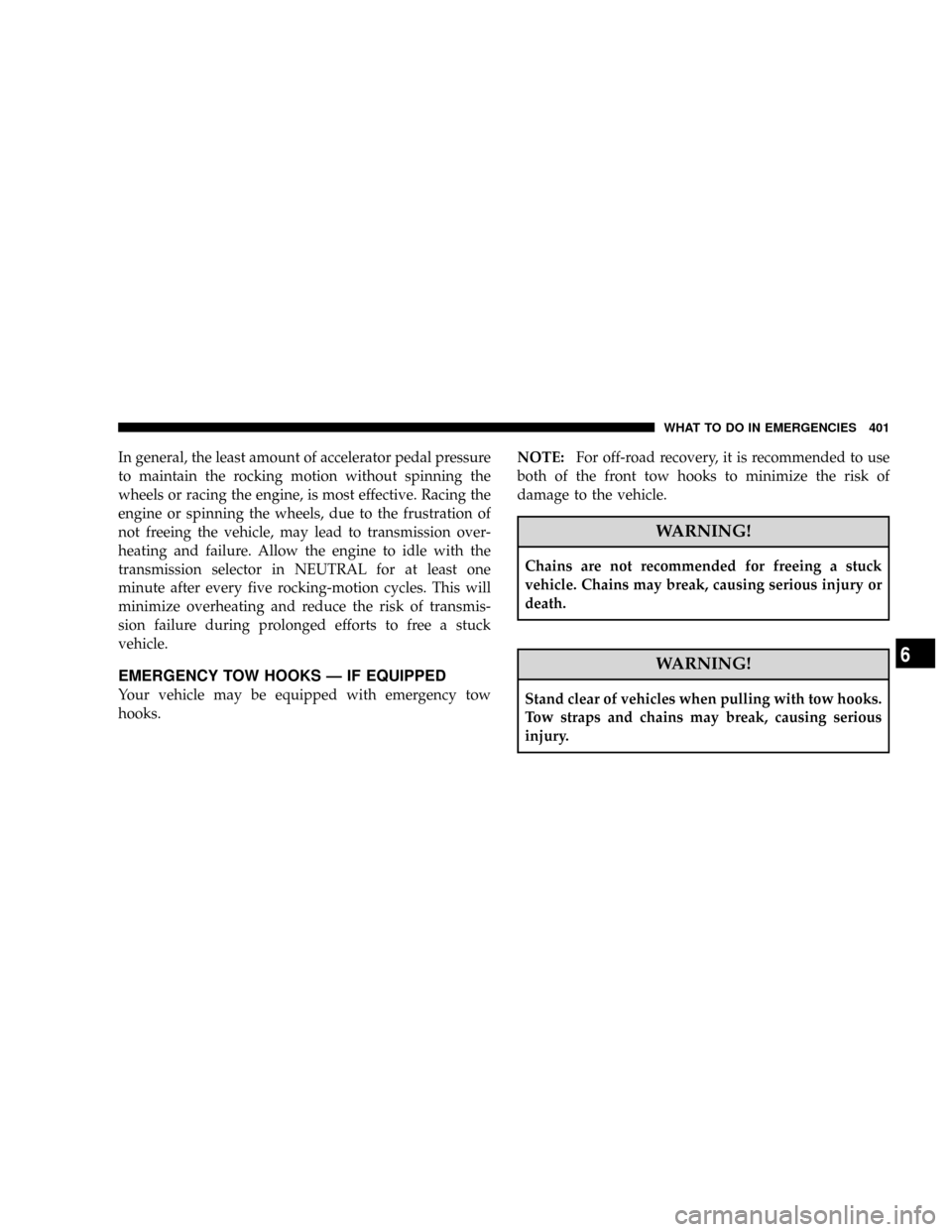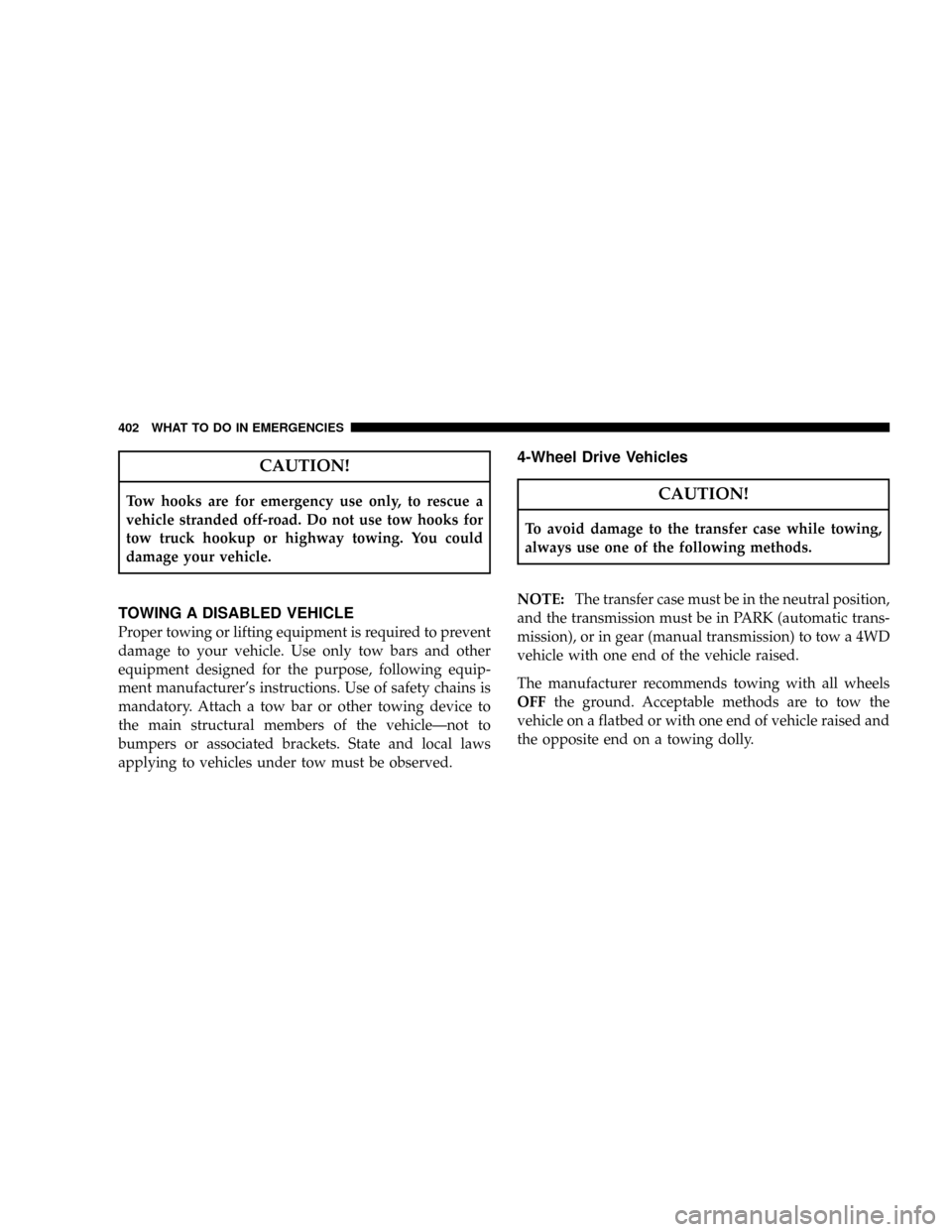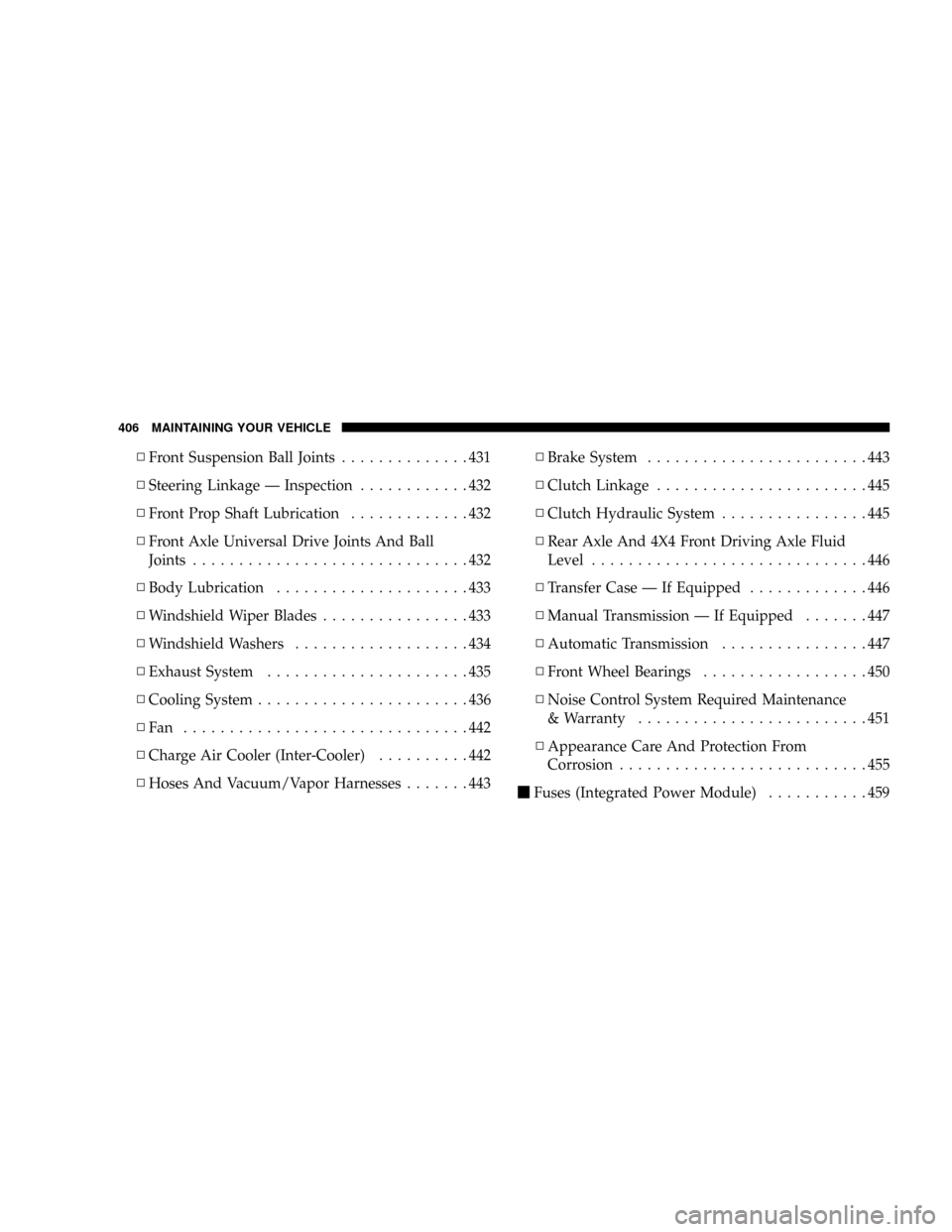Page 403 of 527

In general, the least amount of accelerator pedal pressure
to maintain the rocking motion without spinning the
wheels or racing the engine, is most effective. Racing the
engine or spinning the wheels, due to the frustration of
not freeing the vehicle, may lead to transmission over-
heating and failure. Allow the engine to idle with the
transmission selector in NEUTRAL for at least one
minute after every five rocking-motion cycles. This will
minimize overheating and reduce the risk of transmis-
sion failure during prolonged efforts to free a stuck
vehicle.
EMERGENCY TOW HOOKS Ð IF EQUIPPED
Your vehicle may be equipped with emergency tow
hooks.NOTE:For off-road recovery, it is recommended to use
both of the front tow hooks to minimize the risk of
damage to the vehicle.
WARNING!
Chains are not recommended for freeing a stuck
vehicle. Chains may break, causing serious injury or
death.
WARNING!
Stand clear of vehicles when pulling with tow hooks.
Tow straps and chains may break, causing serious
injury.
WHAT TO DO IN EMERGENCIES 401
6
Page 404 of 527

CAUTION!
Tow hooks are for emergency use only, to rescue a
vehicle stranded off-road. Do not use tow hooks for
tow truck hookup or highway towing. You could
damage your vehicle.
TOWING A DISABLED VEHICLE
Proper towing or lifting equipment is required to prevent
damage to your vehicle. Use only tow bars and other
equipment designed for the purpose, following equip-
ment manufacturer's instructions. Use of safety chains is
mandatory. Attach a tow bar or other towing device to
the main structural members of the vehicleÐnot to
bumpers or associated brackets. State and local laws
applying to vehicles under tow must be observed.
4-Wheel Drive Vehicles
CAUTION!
To avoid damage to the transfer case while towing,
always use one of the following methods.
NOTE:The transfer case must be in the neutral position,
and the transmission must be in PARK (automatic trans-
mission), or in gear (manual transmission) to tow a 4WD
vehicle with one end of the vehicle raised.
The manufacturer recommends towing with all wheels
OFFthe ground. Acceptable methods are to tow the
vehicle on a flatbed or with one end of vehicle raised and
the opposite end on a towing dolly.
402 WHAT TO DO IN EMERGENCIES
Page 405 of 527
2±Wheel Drive Vehicles
Provided that the transmission is operable, tow with the
transmission in NEUTRAL and the ignition key in the
OFF position along with the front wheels raised and the
rear wheels on the ground. Speed must not exceed 30
mph (50 km/h) and distance must not exceed 15 mi (25
km).
CAUTION!
Towing faster than 30 mph (50 km/h) or for more than
15 mi (25 km) can cause severe damage to the
transmission.If the vehicle is to be towed faster than 30 mph (50 km/h)
or more than 15 mi (25 km) the vehicle must be towed
with the rear wheels raised and the front wheels on the
ground. It may also be towed on a flatbed or with the
front wheels raised and the rear wheels on a dolly.
WHAT TO DO IN EMERGENCIES 403
6
Page 408 of 527

NFront Suspension Ball Joints..............431
NSteering Linkage Ð Inspection............432
NFront Prop Shaft Lubrication.............432
NFront Axle Universal Drive Joints And Ball
Joints..............................432
NBody Lubrication.....................433
NWindshield Wiper Blades................433
NWindshield Washers...................434
NExhaust System......................435
NCooling System.......................436
NFan ...............................442
NCharge Air Cooler (Inter-Cooler)..........442
NHoses And Vacuum/Vapor Harnesses.......443NBrake System........................443
NClutch Linkage.......................445
NClutch Hydraulic System................445
NRear Axle And 4X4 Front Driving Axle Fluid
Level..............................446
NTransfer Case Ð If Equipped.............446
NManual Transmission Ð If Equipped.......447
NAutomatic Transmission................447
NFront Wheel Bearings..................450
NNoise Control System Required Maintenance
& Warranty.........................451
NAppearance Care And Protection From
Corrosion...........................455
mFuses (Integrated Power Module)...........459
406 MAINTAINING YOUR VEHICLE
Page 409 of 527
mVehicle Storage........................464
mReplacement Light Bulbs.................465
mBulb Replacement......................466
NHeadlight (Halogen)/Front Park And Turn
Lights.............................466
NFog Lights..........................469
NTail, Stop, Turn And Backup Lights.........470
NCenter High-Mounted Stoplight (CHMSL)
With Cargo Light.....................473
NCab Top Clearance Lights Ð If Equipped....474NTailgate ID Lights (Dual Rear Wheels) Ð If
Equipped...........................476
NRear Light Bar ID Marker (Dual Rear Wheel) Ð
If Equipped.........................477
NSide Marker Lights (Dual Rear Wheels)......478
mFluid Capacities........................479
mFluids, Lubricants And Genuine Parts........480
NEngine.............................480
NChassis............................482
MAINTAINING YOUR VEHICLE 407
7
Page 424 of 527
Draining Fuel/Water Separator Filter (6.7L Diesel
Engine)
CAUTION!
Do not drain the fuel/water separator filter when the
engine is running.
CAUTION!
Do not prefill the fuel filter when installing a new
fuel filter. There is a possibility that debris could be
introduced into the fuel filter during this action. It is
best to install the filter dry and allow the in-tank lift
pump to prime the fuel system.
NOTE:The fuel filter and water separator assembly is
located on the driver's side of the engine. The best access
to the water drain valve is through the driver's side
wheel well.
NOTE:If water is detected in the water separator while
the engine is running or while the key is in the on
position, the WATER IN FUEL LIGHT will illuminate
and an audible chime will be heard five times. At this
point you should stop the engine and drain the water
from the separator.
422 MAINTAINING YOUR VEHICLE
Page 452 of 527

Automatic Transmission Fluid and Filter Change
To obtain best performance and long life for automatic
transmissions, the manufacturer recommends that they
be given regular maintenance service by an authorized
dealer or Service Center. It is important that the trans-
mission fluid is maintained at the correct level, and that
it is drained and refilled as specified.
Use only manufacturer 's recommended transmission
fluid; for correct fluid type, refer to ªAutomatic Trans-
missionº under ªFluids, Lubricants and Genuine Partsº
in this section. It is important that the transmission fluid
be maintained at the prescribed level using the recom-
mended fluid..
The fluid and filter(s) should be changed as specified in
the Maintenance Schedule (Section 8).
NOTE:If the transmission is disassembled for any
reason, the fluid and filter should be changed.
Special Additives
Automatic Transmission Fluid (ATF) is an engineered
product and its performance may be impaired by supple-
mental additives. Therefore, do not add any fluid addi-
tives to the transmission. The only exception to this
policy is the use of special dyes to aid in detecting fluid
leaks. In addition, avoid using transmission sealers as
they may adversely affect seals.
Front Wheel Bearings
Front wheel bearings for your vehicle are sealed-for-life.
They do not require greasing or seal replacement. In
some instances, these bearings will ªpurgeº excess grease
and the bearing housing will look slightly wet. This is
normal.
²Periodic inspection for excess play is recommended.
²If a bearing assembly is accidentally separated when
servicing the brake rotors, it should be replaced.
450 MAINTAINING YOUR VEHICLE
Page 453 of 527
Rear Wheel Bearings
Clean and repack when brake linings are replaced or
rotors resurfaced.
Noise Control System Required Maintenance &
Warranty
For 3500 Two-Wheel Drive and Four-Wheel Drive mod-
els over 10,000 lbs. (4 535 kg) Gross Vehicle Weight
Rating.
All vehicles built over 10,000 lbs. (4 535 kg) Gross Vehicle
Weight Rating and manufactured for sale and use in the
United States are required to comply with the Federal
Government's Exterior Noise Regulations. These vehicles
can be identified by the Noise Emission Control Label
located in the operator's compartment.
MAINTAINING YOUR VEHICLE 451
7